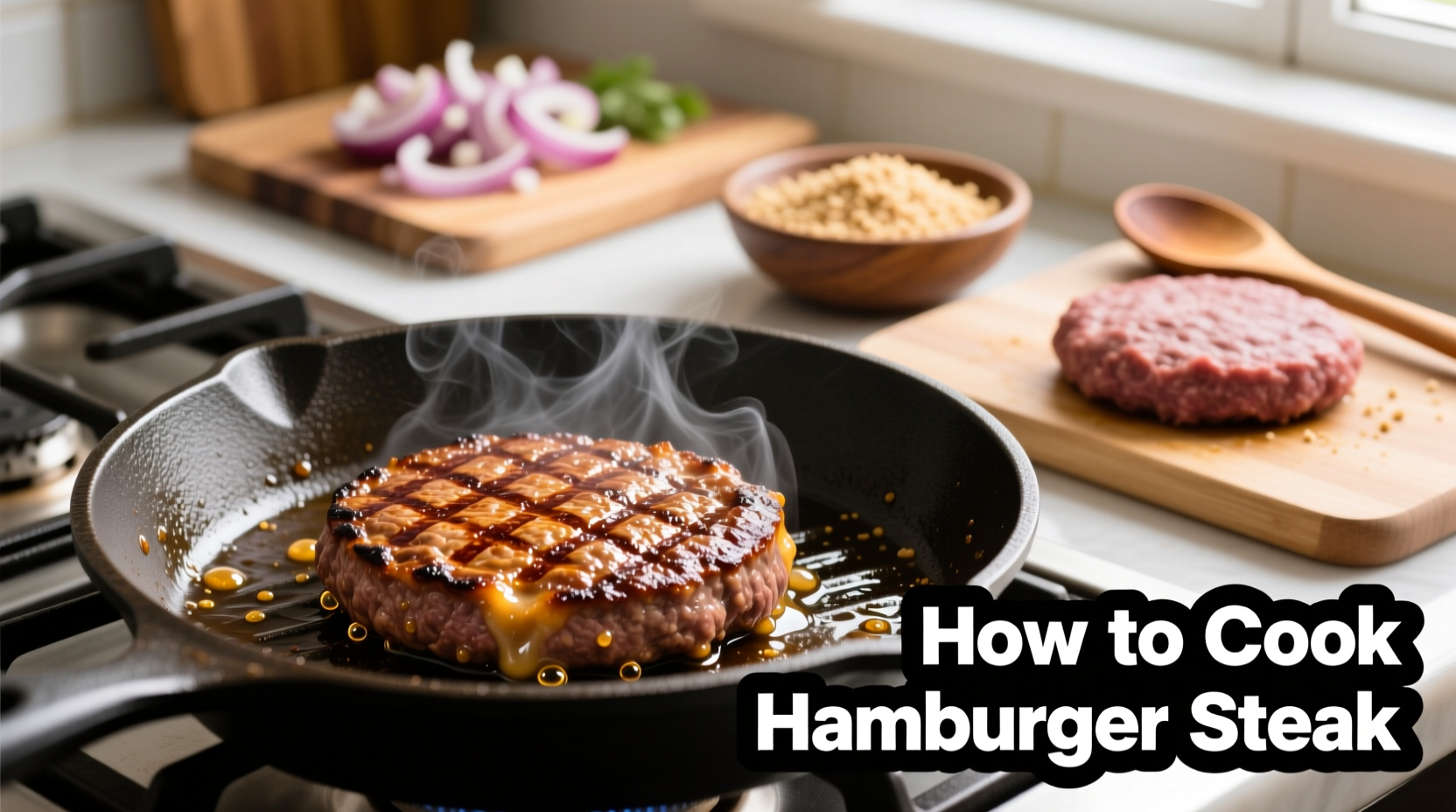Master how to cook hamburger steak with this professional recipe: use 80% lean ground beef, form ¾-inch patties, season simply with salt and pepper, sear in a hot cast-iron skillet for 3-4 minutes per side, and rest for 5 minutes before serving. Perfect results every time.
There's nothing quite like a perfectly cooked hamburger steak—juicy, flavorful, and seared to golden-brown perfection. Whether you're cooking for a weeknight dinner or impressing guests, this guide delivers restaurant-quality results with simple techniques anyone can master. Forget dry, flavorless patties; we'll show you exactly how to achieve that coveted crust while keeping the interior tender and juicy.
Why This Hamburger Steak Method Works
Hamburger steak differs from regular burgers by being served as a standalone entree, often with rich sauces or gravy. The key to success lies in understanding meat science and proper technique. According to the USDA Food Safety and Inspection Service, ground beef must reach 160°F internally to ensure safety, but achieving this without drying out the meat requires precise temperature control and resting time.
| Cooking Method | Internal Temp | Texture Result |
|---|---|---|
| Cast-iron skillet | 155-160°F | Perfect crust, juicy interior |
| Grill | 150-155°F | Slightly drier, charred flavor |
| Non-stick pan | 160°F | Less crust development |
Essential Ingredients for Success
The magic happens with minimal ingredients—quality matters more than quantity. Professional chefs consistently emphasize that proper fat content makes or breaks your hamburger steak.
- Ground beef: 80% lean/20% fat ratio (USDA recommends this balance for optimal juiciness)
- Salt: Kosher salt for even distribution
- Black pepper: Freshly cracked for maximum flavor
- High-smoke point oil: Avocado or canola oil for searing
Avoid common pitfalls like adding breadcrumbs or eggs—they turn your steak into meatloaf. As the National Institute of Food and Agriculture explains, these binders interfere with the Maillard reaction that creates that essential crust.
Step-by-Step Cooking Process
Preparation: The Foundation of Flavor
Start with properly handled meat. Keep ground beef refrigerated until ready to use—never at room temperature. Form patties following these critical steps:
- Divide 1 pound of ground beef into two equal portions (8 ounces each)
- Gently shape into balls, then flatten to ¾-inch thickness
- Create a slight dimple in the center of each patty (prevents bulging)
- Chill patties for 15 minutes before cooking

Searing: Creating the Flavor Foundation
The sear creates complex flavors through the Maillard reaction. Follow these temperature guidelines for perfect results:
- Preheat cast-iron skillet to 400-450°F (medium-high heat)
- Add 1 tablespoon oil and wait until shimmering
- Place patties in skillet without touching
- Cook undisturbed for 3-4 minutes to develop crust
Flip only once using a thin metal spatula. Cook second side for 3-4 minutes for medium (155-160°F internal temperature). Use an instant-read thermometer for accuracy—this is the professional's secret for consistent results.
Resting: The Critical Final Step
Never skip resting! Transfer patties to a wire rack and let rest for 5 minutes. During this time:
- Internal temperature rises 5-10°F (carryover cooking)
- Juices redistribute throughout the meat
- Texture firms up slightly for perfect sliceability
Pro Tips for Restaurant-Quality Results
These techniques separate amateur attempts from professional results:
- Temperature control: Let meat come to 40°F internal temp before cooking (about 30 minutes out of fridge)
- Salt timing: Salt only before cooking—salting earlier draws out moisture
- Butter basting: During last minute of cooking, add 1 tablespoon butter and herbs to skillet and spoon over patties
- Don't press: Never smash patties while cooking—this squeezes out precious juices
Common Mistakes and How to Avoid Them
Even experienced cooks make these errors. Here's how to prevent them:
- Dry patties: Using leaner than 80/20 ground beef—stick to recommended fat ratio
- Uneven cooking: Patties too thick or thin—maintain consistent ¾-inch thickness
- Burning: Heat too high—adjust to maintain 400-450°F range
- Sticking: Skillet not hot enough—wait until oil shimmers before adding patties
Serving Suggestions for Complete Meal
Hamburger steak shines with simple accompaniments that don't overpower its rich flavor:
- Classic pan sauce made from fond left in skillet
- Mashed potatoes or roasted vegetables
- Simple green salad with vinaigrette
For authentic European-style presentation, serve with onion gravy—a technique perfected in German and Japanese cuisine where hamburger steak is a staple entree rather than sandwich component.
Frequently Asked Questions
Can I use different meat blends for hamburger steak?
Yes, but maintain at least 20% fat content. Many chefs blend chuck with short rib (70/30) for enhanced flavor. Avoid leaner blends as they'll dry out during cooking. Never use pre-made seasoned ground beef—it contains additives that interfere with proper searing.
How do I know when my hamburger steak is done?
Use an instant-read thermometer: 145°F for medium-rare (slightly pink), 155°F for medium (light pink), 160°F for well-done (no pink). Visual cues include firmness—press gently; medium should spring back slowly. Never cut to check doneness as this releases juices.
Why does my hamburger steak fall apart during cooking?
This happens when you overwork the meat or add binders like eggs. Handle ground beef minimally—just enough to form patties. Keep meat cold until cooking, and ensure proper fat content (20%). Form patties with a slight dimple in center to prevent bulging and separation.
Can I make hamburger steak ahead of time?
Form patties up to 24 hours ahead and store covered in refrigerator. Never pre-cook completely—you'll lose the essential crust. For best results, cook immediately before serving. If needed, cook to medium-rare, chill rapidly, then finish cooking just before serving.











 浙公网安备
33010002000092号
浙公网安备
33010002000092号 浙B2-20120091-4
浙B2-20120091-4